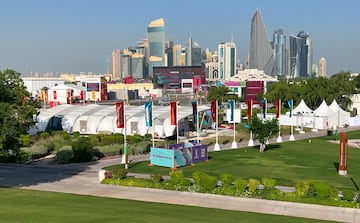Where does Qatar get its food and water from?
How does the Gulf country deal with its awkward geographical location?

As thousands of tourists descend on the nation the size of Yorkshire/Connecticut/Devon and Cornwall - take your pick from those - and with a population only slightly higher than that of Merseyside, the simplest of questions come into play for the World Cup 2022 - what will everyone eat and drink while they’re there?
The question of accommodation has already been handled on AS USA but concerns have rightly been raised about how food and drink will be made available for fans. Qatar sticks out on the end of Saudi Arabia like a thumb poking upwards into the Persian gulf and, as said, is definitely the little brother in terms of the comparative size of its neighbours. Sand dunes and salt flats pepper the country, and most of the natural soil is generally unproductive for agriculture, due to the high winds that blow salt from the sea inland, making farming a practical impossibility.

How does Qatar get its food?
As reported by Dohafamily.com, nearly 90% of Qatar’s food is imported, with almost a quarter of it coming from the USA. The Gulf Cooperation Council (GCC) is a union comprised of Bahrain, Kuwait, Qatar, Oman, Saudi Arabia and the UAE, which helps in sourcing the food. Fruit and vegetables predominantly come from these countries as well as Saudi Arabia and its large dairy exports. Perhaps surprisingly, Australia is the largest exporter of meats to Qatar, followed by New Zealand and India. EU countries are not allowed to supply meat to Qatar, and the USA is not allowed to supply fresh poultry or eggs.
What about the water?
As you might have guessed, Qatar has no natural bodies of permanent fresh water: it’s all salty and horrible and just a few litres would definitely mean a trip to the doctors. It also doesn’t rain a lot. The country also has one of the highest per capita water consumption rates in the world, so, instead of developing gills, the Qataris do what is known as desalination.
Desalination accounts for around half of the water people use in Qatar and the process has quadrupled over the past 20 years. The bad thing is that desalination is a very expensive and energetically wasteful process: it’s a good thing then that the Qataris have deep pockets.
You may also be aware that Qatar produces a lot of oil, and in the process of making one barrel of oil, three to four barrels of water are created. This ‘recycled’ water is actually easier to desalinate than sea water, due to the lower levels of salt, so this method is also used so people can have a nice bath when the temperatures get high.
The only water source that is in surplus in the country is another form of recycled water, which is created by, erm, sewage waste. But don’t worry, this doesn’t come out of the tap. Instead, it’s used for things like irrigation and industrial use.
So, if you’re lucky enough to be at the World Cup, here are some things to keep in mind when you next turn on the tap in your caravan/shipping container hotel.









